Luyang Kong
Learning LLM Preference over Intra-Dialogue Pairs: A Framework for Utterance-level Understandings
Mar 07, 2025Abstract:Large language models (LLMs) have demonstrated remarkable capabilities in handling complex dialogue tasks without requiring use case-specific fine-tuning. However, analyzing live dialogues in real-time necessitates low-latency processing systems, making it impractical to deploy models with billions of parameters due to latency constraints. As a result, practitioners often prefer smaller models with millions of parameters, trained on high-quality, human-annotated datasets. Yet, curating such datasets is both time-consuming and costly. Consequently, there is a growing need to combine the scalability of LLM-generated labels with the precision of human annotations, enabling fine-tuned smaller models to achieve both higher speed and accuracy comparable to larger models. In this paper, we introduce a simple yet effective framework to address this challenge. Our approach is specifically designed for per-utterance classification problems, which encompass tasks such as intent detection, dialogue state tracking, and more. To mitigate the impact of labeling errors from LLMs -- the primary source of inaccuracies in student models -- we propose a noise-reduced preference learning loss. Experimental results demonstrate that our method significantly improves accuracy across utterance-level dialogue tasks, including sentiment detection (over $2\%$), dialogue act classification (over $1.5\%$), etc.
CSR-Bench: Benchmarking LLM Agents in Deployment of Computer Science Research Repositories
Feb 10, 2025



Abstract:The increasing complexity of computer science research projects demands more effective tools for deploying code repositories. Large Language Models (LLMs), such as Anthropic Claude and Meta Llama, have demonstrated significant advancements across various fields of computer science research, including the automation of diverse software engineering tasks. To evaluate the effectiveness of LLMs in handling complex code development tasks of research projects, particularly for NLP/CV/AI/ML/DM topics, we introduce CSR-Bench, a benchmark for Computer Science Research projects. This benchmark assesses LLMs from various aspects including accuracy, efficiency, and deployment script quality, aiming to explore their potential in conducting computer science research autonomously. We also introduce a novel framework, CSR-Agents, that utilizes multiple LLM agents to automate the deployment of GitHub code repositories of computer science research projects. Specifically, by checking instructions from markdown files and interpreting repository structures, the model generates and iteratively improves bash commands that set up the experimental environments and deploy the code to conduct research tasks. Preliminary results from CSR-Bench indicate that LLM agents can significantly enhance the workflow of repository deployment, thereby boosting developer productivity and improving the management of developmental workflows.
GRAM: Generative Retrieval Augmented Matching of Data Schemas in the Context of Data Security
Jun 04, 2024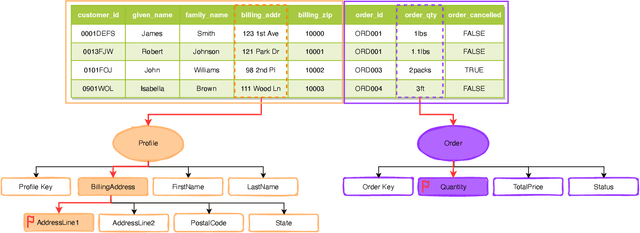
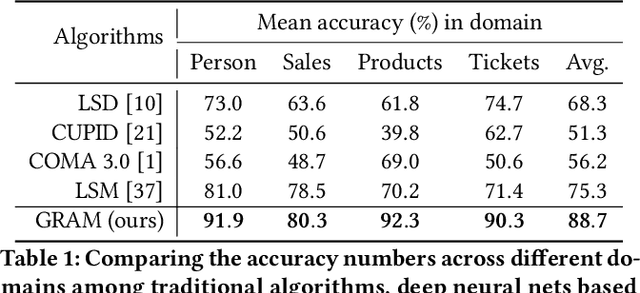

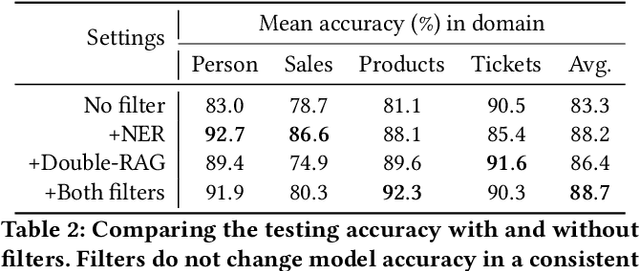
Abstract:Schema matching constitutes a pivotal phase in the data ingestion process for contemporary database systems. Its objective is to discern pairwise similarities between two sets of attributes, each associated with a distinct data table. This challenge emerges at the initial stages of data analytics, such as when incorporating a third-party table into existing databases to inform business insights. Given its significance in the realm of database systems, schema matching has been under investigation since the 2000s. This study revisits this foundational problem within the context of large language models. Adhering to increasingly stringent data security policies, our focus lies on the zero-shot and few-shot scenarios: the model should analyze only a minimal amount of customer data to execute the matching task, contrasting with the conventional approach of scrutinizing the entire data table. We emphasize that the zero-shot or few-shot assumption is imperative to safeguard the identity and privacy of customer data, even at the potential cost of accuracy. The capability to accurately match attributes under such stringent requirements distinguishes our work from previous literature in this domain.
Neural Locality Sensitive Hashing for Entity Blocking
Jan 31, 2024Abstract:Locality-sensitive hashing (LSH) is a fundamental algorithmic technique widely employed in large-scale data processing applications, such as nearest-neighbor search, entity resolution, and clustering. However, its applicability in some real-world scenarios is limited due to the need for careful design of hashing functions that align with specific metrics. Existing LSH-based Entity Blocking solutions primarily rely on generic similarity metrics such as Jaccard similarity, whereas practical use cases often demand complex and customized similarity rules surpassing the capabilities of generic similarity metrics. Consequently, designing LSH functions for these customized similarity rules presents considerable challenges. In this research, we propose a neuralization approach to enhance locality-sensitive hashing by training deep neural networks to serve as hashing functions for complex metrics. We assess the effectiveness of this approach within the context of the entity resolution problem, which frequently involves the use of task-specific metrics in real-world applications. Specifically, we introduce NLSHBlock (Neural-LSH Block), a novel blocking methodology that leverages pre-trained language models, fine-tuned with a novel LSH-based loss function. Through extensive evaluations conducted on a diverse range of real-world datasets, we demonstrate the superiority of NLSHBlock over existing methods, exhibiting significant performance improvements. Furthermore, we showcase the efficacy of NLSHBlock in enhancing the performance of the entity matching phase, particularly within the semi-supervised setting.
Entity Anchored ICD Coding
Aug 15, 2022



Abstract:Medical coding is a complex task, requiring assignment of a subset of over 72,000 ICD codes to a patient's notes. Modern natural language processing approaches to these tasks have been challenged by the length of the input and size of the output space. We limit our model inputs to a small window around medical entities found in our documents. From those local contexts, we build contextualized representations of both ICD codes and entities, and aggregate over these representations to form document-level predictions. In contrast to existing methods which use a representation fixed either in size or by codes seen in training, we represent ICD codes by encoding the code description with local context. We discuss metrics appropriate to deploying coding systems in practice. We show that our approach is superior to existing methods in both standard and deployable measures, including performance on rare and unseen codes.
Kronecker Factorization for Preventing Catastrophic Forgetting in Large-scale Medical Entity Linking
Nov 11, 2021
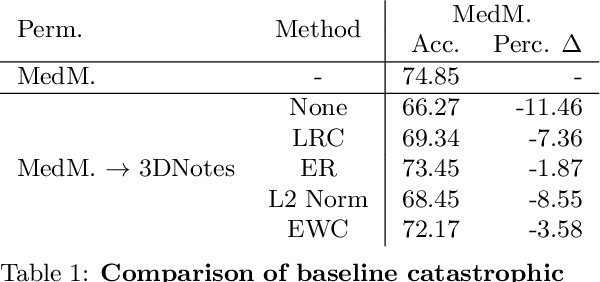

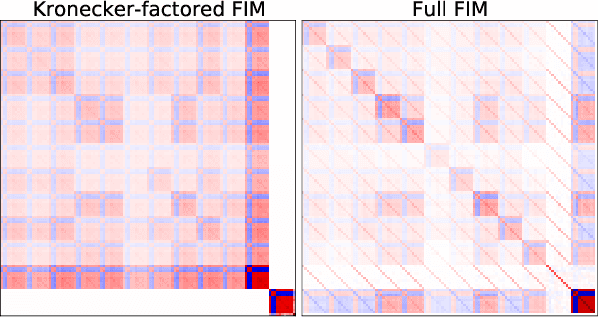
Abstract:Multi-task learning is useful in NLP because it is often practically desirable to have a single model that works across a range of tasks. In the medical domain, sequential training on tasks may sometimes be the only way to train models, either because access to the original (potentially sensitive) data is no longer available, or simply owing to the computational costs inherent to joint retraining. A major issue inherent to sequential learning, however, is catastrophic forgetting, i.e., a substantial drop in accuracy on prior tasks when a model is updated for a new task. Elastic Weight Consolidation is a recently proposed method to address this issue, but scaling this approach to the modern large models used in practice requires making strong independence assumptions about model parameters, limiting its effectiveness. In this work, we apply Kronecker Factorization--a recent approach that relaxes independence assumptions--to prevent catastrophic forgetting in convolutional and Transformer-based neural networks at scale. We show the effectiveness of this technique on the important and illustrative task of medical entity linking across three datasets, demonstrating the capability of the technique to be used to make efficient updates to existing methods as new medical data becomes available. On average, the proposed method reduces catastrophic forgetting by 51% when using a BERT-based model, compared to a 27% reduction using standard Elastic Weight Consolidation, while maintaining spatial complexity proportional to the number of model parameters.
Zero-shot Medical Entity Retrieval without Annotation: Learning From Rich Knowledge Graph Semantics
May 26, 2021
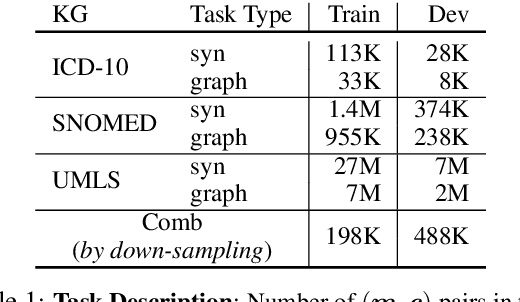
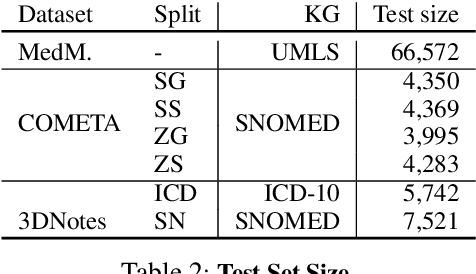
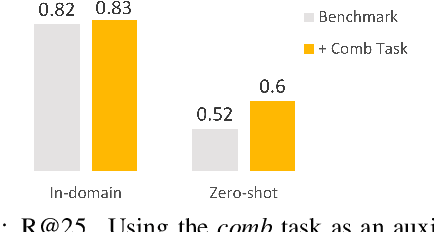
Abstract:Medical entity retrieval is an integral component for understanding and communicating information across various health systems. Current approaches tend to work well on specific medical domains but generalize poorly to unseen sub-specialties. This is of increasing concern under a public health crisis as new medical conditions and drug treatments come to light frequently. Zero-shot retrieval is challenging due to the high degree of ambiguity and variability in medical corpora, making it difficult to build an accurate similarity measure between mentions and concepts. Medical knowledge graphs (KG), however, contain rich semantics including large numbers of synonyms as well as its curated graphical structures. To take advantage of this valuable information, we propose a suite of learning tasks designed for training efficient zero-shot entity retrieval models. Without requiring any human annotation, our knowledge graph enriched architecture significantly outperforms common zero-shot benchmarks including BM25 and Clinical BERT with 7% to 30% higher recall across multiple major medical ontologies, such as UMLS, SNOMED, and ICD-10.
Improve black-box sequential anomaly detector relevancy with limited user feedback
Sep 15, 2020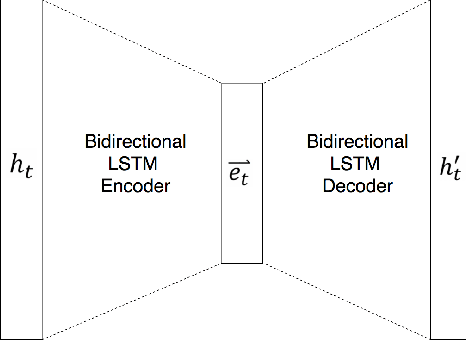


Abstract:Anomaly detectors are often designed to catch statistical anomalies. End-users typically do not have interest in all of the detected outliers, but only those relevant to their application. Given an existing black-box sequential anomaly detector, this paper proposes a method to improve its user relevancy using a small number of human feedback. As our first contribution, the method is agnostic to the detector: it only assumes access to its anomaly scores, without requirement on any additional information inside it. Inspired by a fact that anomalies are of different types, our approach identifies these types and utilizes user feedback to assign relevancy to types. This relevancy score, as our second contribution, is used to adjust the subsequent anomaly selection process. Empirical results on synthetic and real-world datasets show that our approach yields significant improvements on precision and recall over a range of anomaly detectors.
Using generative adversarial networks to synthesize artificial financial datasets
Feb 06, 2020



Abstract:Generative Adversarial Networks (GANs) became very popular for generation of realistically looking images. In this paper, we propose to use GANs to synthesize artificial financial data for research and benchmarking purposes. We test this approach on three American Express datasets, and show that properly trained GANs can replicate these datasets with high fidelity. For our experiments, we define a novel type of GAN, and suggest methods for data preprocessing that allow good training and testing performance of GANs. We also discuss methods for evaluating the quality of generated data, and their comparison with the original real data.
 Add to Chrome
Add to Chrome Add to Firefox
Add to Firefox Add to Edge
Add to Edge